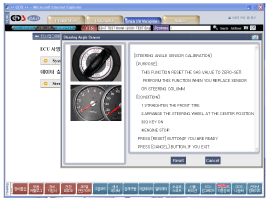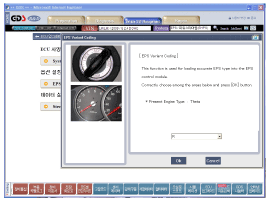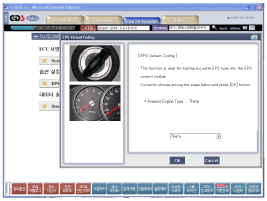 Hyundai Sonata: Repair procedures
Hyundai Sonata: Repair procedures
General Inspection
After or before servicing the EPS system, perform the troubleshooting
and test procedure as follows. Compare the system condition with normal condition
in the table below and if abnormal symptom is detected, perform necessary remedy
and inspection.
|
Test condition |
Normal condition: Motor must not supply steering assist. |
||
|
Symptom |
Possible cause |
Remedy |
|
|
IG Off |
Motor supplies steering assist. |
ASP is not calibrated. |
Perform the ASP calibration using a scan tool. |
|
IG power supplies |
Inspect the IG power supply line. |
||
|
Test condition |
Normal condition: Motor must not supply steering assist, Warning lamp
is illuminated. |
||
|
Symptom |
Possible cause |
Remedy |
|
|
IG On/Engine Off |
Motor supplies steering assist. |
ASP is not calibrated. |
Perform the ASP calibration using a scan tool. |
|
EMS CAN signal is not received. |
Inspect the CAN line. |
||
|
Warning lamp is not illuminated. |
Cluster fault |
Inspect the cluster and cluster harness |
|
|
Test condition |
Normal condition: Motor supplies steering assist, Warning lamp is
not illuminated. |
||
|
Symptom |
Possible cause |
Remedy |
|
|
IG On/Engine On |
Warning lamp is illuminated and Motor dose not supply steering assist. |
EPS (Hot at all times) and IG power supply fault |
Inspect the connector and harness for EPS (Hot at all times) and IG
power supply line. |
|
DTC is detected by system. |
Perform the self test using a scan tool and repair or replace. |
||
|
Warning lamp is illuminated and Motor supplies steering assist. |
ASP is not calibrated. |
Perform the ASP calibration using a scan tool. |
|
|
CAN communication between EPS and cluster is fault. |
Inspect the CAN line. |
||
ASP: Absolute Steering Position
CAN: Controller Area Network
EMS: Engine Management System
The following symptoms may occur during normal vehicle operation
and if there is no EPS warning light illumination, it is not malfunction
of EPS system.
|
Caution when ASP (Absolute Steering Position) calibration or EPS type recognition
| • |
Check if the battery is fully charged before ASP calibration or
EPS type recognition.
|
| • |
Be careful not to disconnect any cables connected to the vehicle
or scan tool during ASP calibration or EPS type recognition.
|
| • |
When the ASP calibration or EPS type recognition is completed,
turn the ignition switch off and wait for several seconds, then start
the engine to confirm normal operation of the vehicle.
|
ASP Calibration
| 1. |
Select "Steering Angle Sensor".
|
| 2. |
Proceed with the test according to the screen introductions.
|
EPS Type Recognition Procedure
| 1. |
Select "EPS Variant Coding".
|
| 2. |
Proceed with the test according to the screen introductions.
|
 Description and Operation
Description and Operation
Description
EPS (Electric power steering, Column assist type) system uses an electric
motor to assist the steering force and it is an engine operation independent
steering system.
EPS ...
 Steering Column and Shaft. Repair procedures
Steering Column and Shaft. Repair procedures
Replacement
1.
Disconnect the battery negative cable from the battery and then
wait for at least 30 seconds.
2.
Turn the steering wheel so ...
See also:
Antenna
Glass antenna
When the radio power switch is turned on while the engine start/stop button is
in either the “ON” or “ACC” position, your car will receive both AM and FM broadcast
signa ...
Steering Gear box. Components and Components Location
Components
1. Tie rod end
2. Lock nut
3. Bellows
4. Bellows band
5. Tie rod
6. Rack bar
7. Dust packing
8. Dust cap
9. Oil seal
10. Pinion p ...
Injector. Description and Operation
Description
Based on information from various sensors, the ECM can calculate the fuel
amount to be injected. The fuel injector is a solenoid-operated valve and the
fuel injection amount is c ...



